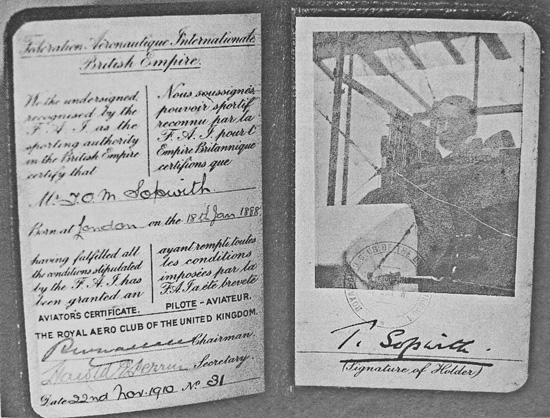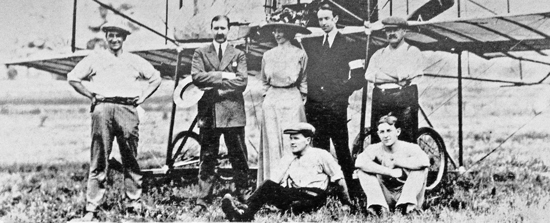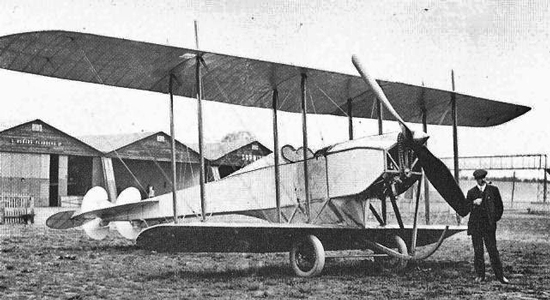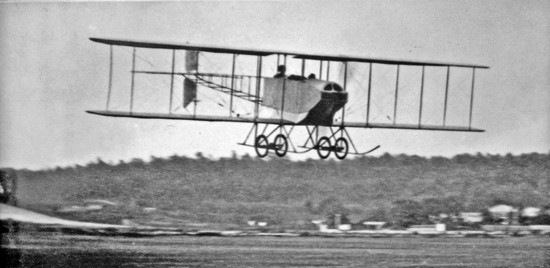The Origins of the Sopwith Aviation Company
18th January 1888 Thomas Octave Murdoch Sopwith is born in London, youngest of eight and the only boy.
At 10 years old Thomas witnesses his mining engineer and mine owner father being killed in a tragic shooting accident.
At 13 years old Thomas’ application to the Dartmouth Royal Naval College as a cadet naval officer is rejected, ending his dream of a career involving boats and sailing. Instead, he goes to Seafield Park Engineering College at Lee-on-Solent which has machine shops, laboratories and an impressive range of cars and motorcycles. (below, Thomas second from the left)

In 1904, at 16 years old, Thomas wins the Hatfield 100 Mile Reliability Trial in a 6½hp Pearson three-wheeler.
In 1906 Thomas and friend Phil Paddon jointly own the gas balloon “Padsop” initially flown with instruction from Charles Rolls.

Also in 1906 Thomas is the youngest competitor in the Isle of Man Tourist Trophy Race in a 2-cylinder Peugeot.
In 1909 Thomas and Bill Eyre buy 166ton schooner “Neva”. Refurbishing and modernising it, they employ mechanic Fred Sigrist from the Parsons Motor Co to install and maintain a paraffin engine.
In January 1910 on a frozen lake near Montreux, Thomas is goal tender in the British team which wins the first European Ice Hockey Championship.
In September 1910, Thomas pays £5 for a pleasure flight in a Farman biplane at Brooklands. He decides to take up flying as another hobby and immediately buys a 40hp monoplane from Howard T Wright of Battersea.

21st October 1910 Thomas starts teaching himself to fly at the airfield inside the 1907 Brooklands motor race track. Starting with short hops, he soon crashes the monoplane. The broken undercarriage and propeller are quickly repaired and he makes straight flights and then a few circuits over another five days before a burst cylinder head puts a stop to his fun.
Thomas buys a 60hp Howard Wright biplane and on 21st November 1910 completes the three circuits, figure of eight and accuratelanding test to gain Royal Aero Club Aviator’s Certificate No.31. (below again) Later that day he takes up the biplane’s designer W O Manning as a passenger.

24th November 1910 Thomas, with 10 hours flying experience, flies 107 miles making the longest cross-country flight in Britain so far and aiming to win the 1910 £500 Michelin Prize.

18th December 1910 with the top wings of the Howard Wright extended and a modified pram hood to keep his feet warm, Thomas flies 169 miles from Eastchurch to Belgium to win the £4,000 Baron De Forest Prize for the longest non-stop flight from Britain to Europe in 1910.

31st December 1910 Thomas flies 150 miles for the 1910 Michelin Prize but is pipped later that that last day by S F Cody’s 195 miles.
1st February 1911 Thomas flies from Brooklands in his Howard Wright biplane to land on the east lawn of Windsor Castle to meet King George V and his three sons.
In March 1911 Thomas buys a 50hp Gnome engined tandem two-seat Martinsyde 4B “Dragon Fly” but on 17th April damages a wing on landing and it cannot be repaired in time for his planned trip to America. He goes to Paris and buys a 70hp tandem two-seat Bleriot monoplane.
By May 1911 Thomas is in New York with his sister May, a Tour Manager, Fred Sigrist (far left) and two other English mechanics. He soon crashes the 70hp two-seat Bleriot in a gust of wind and orders another from France continuing demonstrations and lucrative $50 passenger flights in his Howard Wright biplane. (below)

29th May 1911 at the start of the Columbus Ohio Aviation Meet their tent hangar is blown down in a gale. They rapidly repair the Howard Wright but Thomas crashes it four days later and it takes 20 days to repair. Meanwhile the Wright Brothers make a formal legal complaint that the British Howard-Wright infringes their patents. Thomas mollifies them by buying an American Burgess-built Wright biplane. (below)

12th to 22nd August 1911 at the Chicago Aviation Meet Thomas takes a joint world climb record in his new 70hp Bleriot monoplane No.7 (below) which also wins fastest 2-man competitions, winning similar three-man prizes in his Burgess-Wright biplane. He is the most successful of 34 competitors with $14,020 prize money.

26th August to 6th September 1911 at the Boston Meet Thomas is again the most successful winning $6,022 with 12 firsts and 8 seconds out of 26 contests entered.
10th September 1911 in turbulent winds off Brighton Beach New York Thomas and passenger in the Howard Wright fail to reach the beach with a spluttering engine and flip upside down into the sea but are quickly rescued.

23rd to 30th September 1911 at the Nassau Boulevard, Long Island Meet Thomas wins another $5,200 with 7 firsts and 12 second places. In many of these events one of his main rivals has been his British friend Claude Graham White in a 75hp Nieuport monoplane.
The Sopwith team arrive home in October 1911. Awaiting the return of his aircraft from America, Thomas flies the latest 65hp Antoinette-engined Martinsyde monoplane.(below) On 31st December 1911 he damages the propeller and undercarriage landing at St Albans.

Sopwith through 1912
1st February 1912 24-years-old Thomas Sopwith opens the Sopwith School of Flying at Brooklands with his original monoplane and the three aircraft back from America. He soon recruits Fred Raynham as School Manager and Instructor leaving him free to explore other opportunities, whilst enjoying competition flying and his many other hobbies.

By 7th March 1912 Fred Sigrist and his small team have rebuilt the crashed two-years old Howard Wright biplane with a 40hp ABC engine. They have also fitted the America Burgess Wright biplane with dual controls.
21st April 1912 The Gnome engine in the Burgess Wright throws a cylinder over Brooklands but is safely landed by a slightly injured Fred Rainham.
By 2nd May 1912 the Burgess Wright biplane has been completely rebuilt with a 35hp Green engine. A Henri Farman biplane is bought for the school fleet as a standard type for basic flying tuition.
5th May 1912 Thomas wins the Malcolm Cup cross-country race from Brooklands to Chertsey and back in his 70hp Bleriot. He then makes the first flight in W O Manning’s extraordinary 100hp Coventry Ordnance Works biplane with its huge chain-driven propeller, before taking up three passengers, two sitting on the wings.

During May 1912 Thomas goes to Paris and flies in a small Donnet-Lévêque pusher biplane flying boat, reportedly flying under a Seine river bridge. He decides to build his own small flying boat and orders a double-skinned plywood hull from boatbuilders Saunders of Cowes.
8th June 1912 Thomas wins the first Hendon Aerial Derby, flying 81 miles around London in his Bleriot monoplane.

29th June 1912 23-years-old Australian motor mechanic Harry Hawker, having worked briefly for Commer, Mercedes and Austro-Daimler since coming to England, starts his dream job working for Fred Sigrist as a mechanic with the Sopwith School of Flying at Brooklands alongside his Australian friend Harry Kauper.
Sigrist’s small team have just completed their own-designed biplane using the 70hp Gnome rotary engine from their Bleriot, wings similar to the Burgess-Wright biplane and a wood frame fuselage set between the wings with rudders and elevators at the rear. “It is altogether neater than their pusher engined biplanes”. Because of its mixed heritage the machine becomes known as the Sopwith “Hybrid”.

4th July 1912 Thomas is pleased with his first flight in his ‘Hybrid’. It is slower than expected but climbs exceptionally well and he immediately demonstrates that it can fly with two passengers in the front cockpit.

9th July 1912 E W Copland-Perry replaces Fred Raynham as Sopwith School Manager and Instructor “with a view to hydro-aeroplane flying having had some experience of this at the Royal Aircraft Factory”.
12th July 1912 Gordon Bell and passenger start out from Brooklands in the Sopwith ‘Hybrid’ on their way to Cowes to see Thomas practising for the Harmsworth Trophy speedboat race. Banking too steeply after take-off they side-slip down into the Brooklands sewage farm, a fairly common occurrence in those days, messy but rarely fatal. They are unhurt but the machine needs a complete rebuild.
31st July 1912 After a rapid course of instruction at the Sopwith School, Major Hugh Trenchard gains his aviator’s certificate just days before his 40th birthday, the deadline to be eligible for a transfer to the Royal Flying Corps.
2nd August 1912 Thomas is at Larkhill, Salisbury Plain to fly the Coventry Ordnance Works biplane in the Military Aircraft Trials. It does not perform well and it is withdrawn after Fred Rainham takes over from Thomas.
22nd August 1912 Thomas is in Huntington Bay, New York State, at the helm of Saunders of Cowes built `Maple Leaf IV’, the British entry for the 1912 Harmsworth Trophy races. The Americans have won the last four years but the 40ft long, five-step hydroplaning hull and twin engines modified by Austin Motors to each give 400hp is enough for Thomas to win the prestigious trophy for Britain.

There is plenty of work in the Sopwith workshop with a complete rebuild of the Burgess-Wright biplane with a British in-line engine, rebuilding their crashed ‘Hybrid’ and building the small flying boat.
However, by late August new Australian mechanic Harry Hawker has talked Thomas Sopwith into giving him cut-price early morning flying lessons in the Henri Farman biplane and is proving to be an exceptional student. On 17th September 1912 Harry Hawker passes the tests to gain Royal Aero Club Aviator’s Certificate No 297.
18th September 1912 Thomas and a passenger make the first flight in the newly rebuilt ‘Hybrid’, now with a 50hp engine, two-wheel undercarriage and fully covered fuselage.

8th October 1912 Thomas flies the ‘Hybrid’ to Farnborough with a passenger in 143 minutes despite an unsuitable propeller. In their tests with one passenger, it reaches 1,000 feet in three minutes and just 50.6mph but handles well right down to 35mph.
10th October 1912 Howard T Wright, the builder of Thomas’ first two aircraft, passes his aviator’s certificate tests in the Sopwith School’s Henri Farman.
13th October 1912 Now known as the Sopwith Wright, the much-modified Burgess-Wright gets its first outing. To qualify as British for the Michelin Trophy competition it has been completely re-built with a 40hp ABC engine beside the pilot and a protective nacelle in front.
By now Sopwith’s little tractor-engined biplane flying boat has been completed but is not a success and languishes outside Saunders’ sheds at East Cowes. (below) The Sopwith team are devising a larger flying boat with a pusher engine set further back and a long speedboat-type hull also from Saunders of Cowes.

By 21st October 1912 Thomas has registered the Sopwith Aviation Company as his latest enterprise and it is immediately in business. His demonstrations of the Sopwith ‘Hybrid’ have impressed observers and the Admiralty decides to buy it for £900 for their Naval Flying School at the Eastchurch flying ground on the Isle of Sheppey.
21st October 1912 Ex-Kingston schoolmaster Reg Ashfield joins Sopwith as the draughtsman at £3 a week, much more than his teacher’s pay. In these early days the aircraft were devised jointly by Sopwith, Sigrist and Hawker with Reg Ashfield often drawing them as they were being built.
From 15th October to 22nd October 1912 Harry Hawker is flying the Sopwith-Wright biplane in attempts at the Michelin flight duration prize but has been stopped short by a broken valve spring, next by buffeting winds and finally, after more than three hours, by a magneto shorting in the rain.
24th October 1912 Harry Hawker starts at dawn but again experiences magneto trouble. With a new magneto he restarts at 9.17 initially in thick fog. During the afternoon Thomas makes flights alongside him in the ‘Hybrid’ as Harry continues his circuits over Brooklands with the engine throttled down until, almost totally dark and just before the competition time-limit, he is guided in by bonfires to take the British endurance record to eight hours and twenty-three minutes winning the 1912 Michelin Trophy and the £500 prize.

22nd November 1912 Harry Hawker and Harry Kauper set out from Brooklands to deliver the ‘Hybrid’ to Eastchurch but in fog with a malfunctioning compass they land at Croydon. They complete the delivery the following morning and it becomes Admiralty aircraft No.27 alongside their other aircraft mostly from Short Brothers.
Confident that he can sell more aircraft like the ‘Hybrid’ and determined to build a larger flying boat, Thomas Sopwith has been searching around for a ready-made factory with a source of skilled labour. What he has found is a roller-skating rink near the railway station and goods yards in the centre of Kingston upon Thames. It is the first building in Canbury Park Road immediately behind the Cinem Palace cinema on the Richmond Road.
23rd December 1912. The Sopwith Aviation Company takes a £300 pa 14 years lease on the rink. This wide roof span building with very flat wooden floor is ideal for aircraft manufacture whilst skilled woodworkers can be recruited from Kingston’s many boatbuilding and coachbuilding companies and women workers recruited from the adjacent densely populated streets. There is no need for an airfield as Thomas retains the sheds at Brooklands for flight testing which is only 12 miles by road.
This completes the Sopwith Aviation Company story up to its time in Kingston upon Thames
Go back to “Sopwith day by day” and select “1913” to continue


